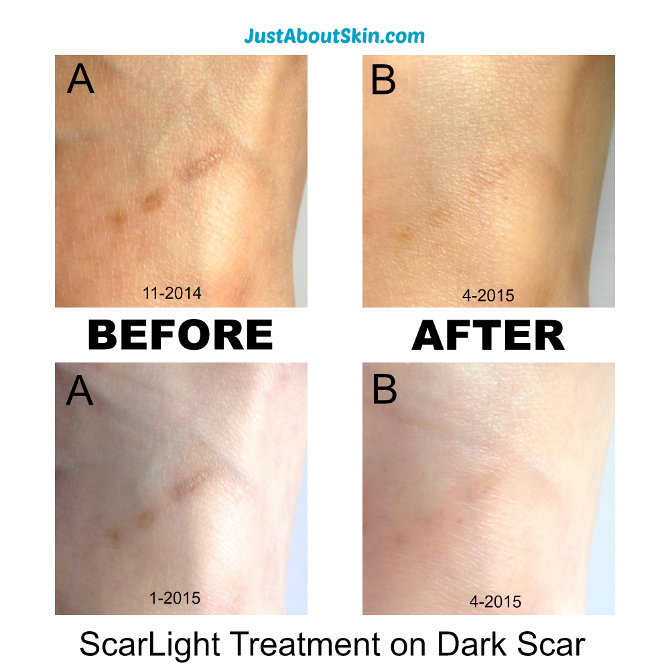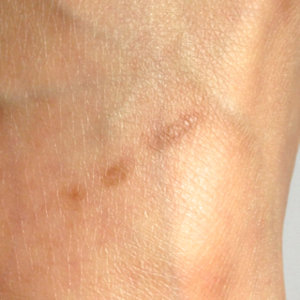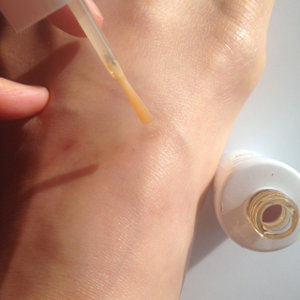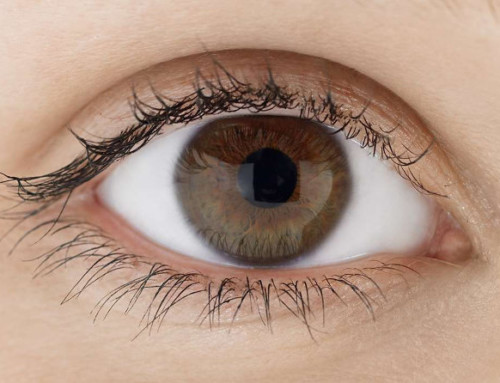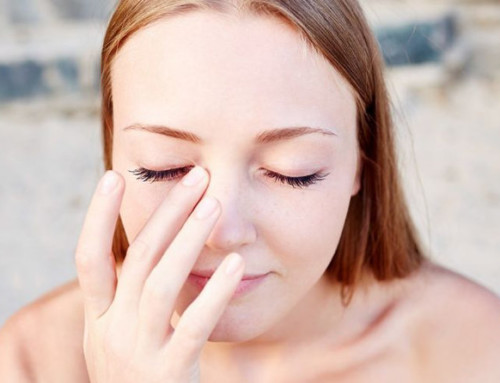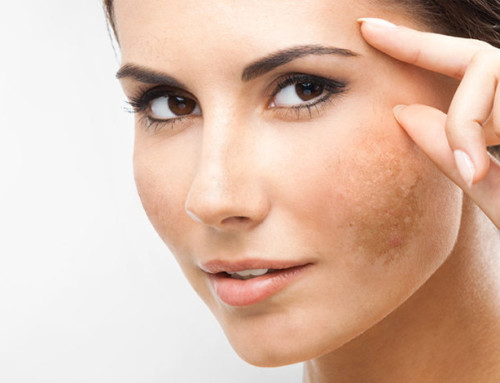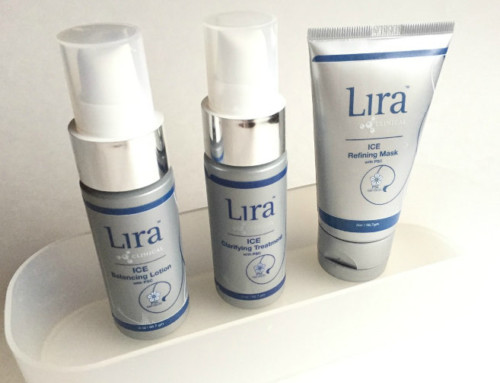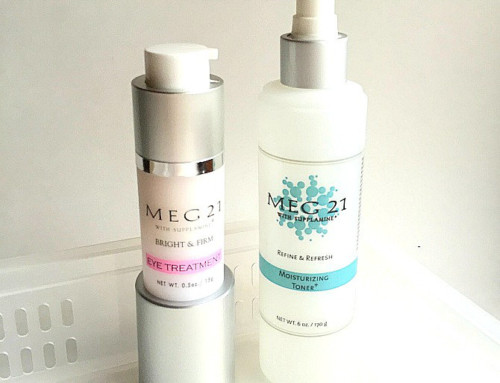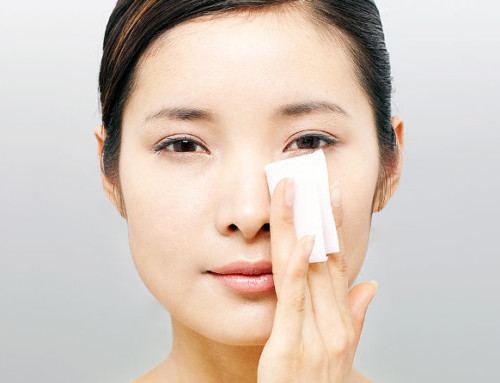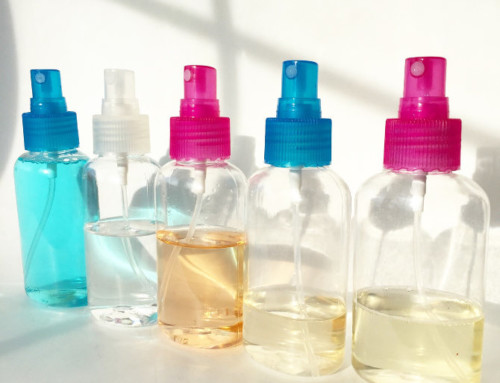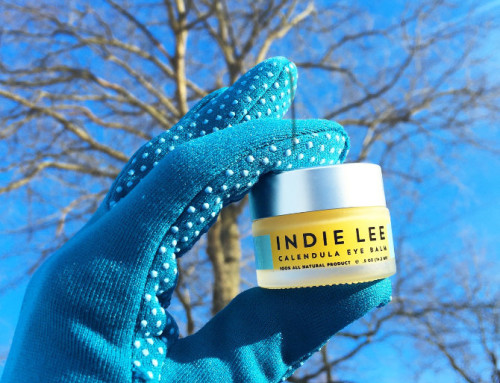Yesterday, I shared my progress with ScarGuard for the burn scars on my hand. Today, I’d like to share the results of the ScarLight treatment for a dark scar on my foot.
The dark scar you see in this photo is about two years old. The scar is on the top part of my foot. This is BEFORE any treatment.
I got the scar from banging my foot against a door. It was actually a very small wound. A scratch really. I wouldn’t even call it a wound, since there was no blood. Just the skin scratched off, exposing a bit of raw skin.
That ‘scratch’ became a dark scar. The scar became much wider than the actual scratch (a thin line)! You can read more about what I didn’t do right to prevent this from happening here.
The dark color of the scar is known as Post-Inflammatory Hyperpigmentation (PIH), which is common after the skin has experienced some trauma. Acne scarring is an example of PIH.
Dark Scar Treatment Progression
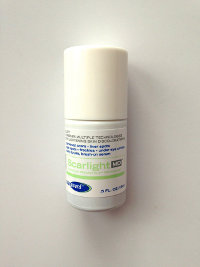 I began using Scarlight (made by ScarGuardMD) at the end of January 2015. My usage was not consistent though. You are supposed to apply Scarlight twice a day. But I was not compliant with the recommended frequency. At night, I would feel too tired to apply it before bed. In the morning, I was in too much a rush. During the month of February and March, my usage was very inconsistent.
I began using Scarlight (made by ScarGuardMD) at the end of January 2015. My usage was not consistent though. You are supposed to apply Scarlight twice a day. But I was not compliant with the recommended frequency. At night, I would feel too tired to apply it before bed. In the morning, I was in too much a rush. During the month of February and March, my usage was very inconsistent.
At the end of March, I began to use Scarlight more regularly. During the past 4 weeks, I have managed to use Scarlight at least once a day, and for at least 50% of the time, twice a day.
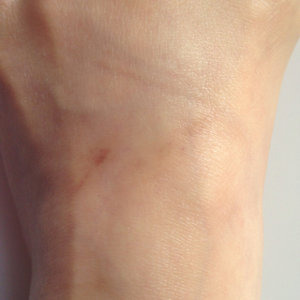
The scar today. It has faded significantly. The red mark on the left is a new scar from a separate scratch.
As you can see from the Before & After photos above and the photo on the left (taken 2 days ago), my results have been excellent!
I am quite surprised by how much the scar has faded given the short period of time. The scar might be even lighter if I had applied this twice daily consistently.
How To Apply ScarLight
Scarlight is super easy to use. It is a thick liquid that comes in a bottle with a brush. You brush the liquid over the areas that you want to lighten.
I really love the brush. It makes it much easier to use than a cream that I have to squeeze from a tube and rub in with my fingers. It also makes the application much more precise. With the brush, it’s easy to dab onto small areas. If you have a large area to treat, the brush would not be practical.
After brushing the liquid on my skin, I let it dry. It doesn’t take long. A minute or so.
The color of the liquid is an amber yellow. When it dries on my skin, it makes the skin slightly darker but not by much. The color fades after several hours.
What Is In ScarLight?
Scarlight is a 2% Hydroquinone lightening treatment that is available in doctor’s offices or authorized retailers. Hydroquinone is the only FDA approved lightening ingredient in the U.S. It is classified as a drug.
The maximum concentration of Hydroquinone allowed in an OTC product, such as this one, is 2%. For a greater concentration (such as 4%), you need a doctor’s prescription.
Hydroquinone is a controversial ingredient. The professional skincare community is divided about it. Some skincare professionals and manufacturers believe it poses some health risks and is potentially irritating to skin. The dermatology community, FDA, other skincare professionals and manufacturers believe it is safe for use on skin.
The objections and concerns about Hydroquinone are:
- effective but can be irritating at >2% concentration; >4% may be cytotoxic (HQ causes apoptosis in melanocyte cells and may cause damage in neighboring cells)
- can lead to exogenous ochronosis (an increase in pigmentation that is serious and hard to treat, skin of color is more at risk) or hypopigmentation
- repigmentation may occur after treatment is discontinued in skin of color
- some people are allergic to it (as many as one-third of the population could be)
- may cause contact dermatitis in some people
- may cause photosensitivity with extended use
- not recommended for use in large areas of skin
- widely thought to have carcinogenic effects, but the studies that are cited are based on tests with high doses in mice; the FDA and dermatology community believe hydroquinone is safe for use
- more tightly regulated in other countries outside the U.S. (not actually banned in Europe or Canada, contrary to popular belief)
To satisfy divergent customer preferences and needs, some professional skincare companies make two versions of their brightening treatments – a version with Hydroquinone and a version that is Hydroquinone-free.
Hydroquinone Is Not Suitable For Everyone
Despite the controversy over Hydroquinone, one thing is clear:
On certain Fitzpatrick skin types (Types 4-6, darker skin tones), there is a risk with using Hydroquinone.
On darker skin tones, Hydroquinone may cause changes in the color of the skin – the area being treated might become darker or lighter than its natural color.
This risk is similar to the risk of other ingredients, such as Tretinoin or the AHA’s in strong chemical peels, on darker skin tones.
I’m very pleased with the results of the Scarlight treatment on my dark scar. Like with most fading treatments, I did not harbor high expectations going in, but Scarlight has truly exceeded mine. I’ll continue using this for a little while longer on the original scar. And then the neighboring scar will get all the attention!
Related Posts:
- Burn Scar Case Study: How I Treated A Burn Scar With ScarGuard & Other Techniques
- ScarGuard Scar Treatment for Raised and Discolored Scars
- Risks for Skin of Color
- A Review of Brightening Ingredients
Want articles & posts delivered straight to your inbox? Sign up for the weekly newsletter here.

